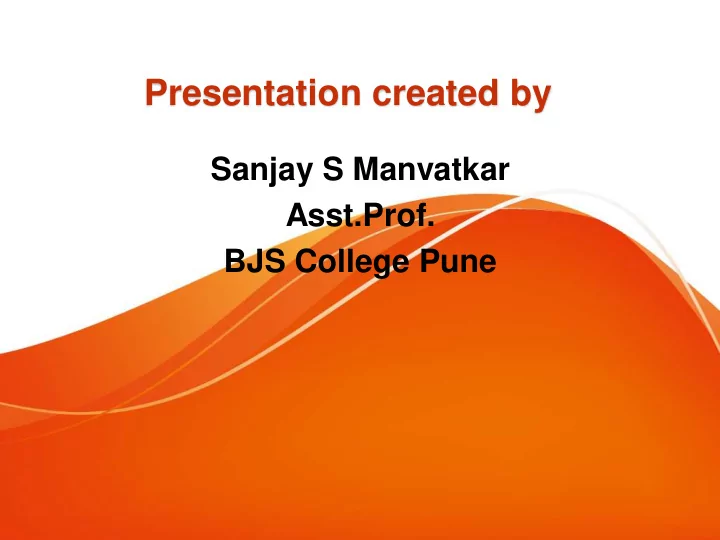

Presentation created by Sanjay S Manvatkar Asst.Prof. BJS College Pune
6. Software Testing • Topic Covered in • Types of Testing.:- 1. Manual V/S Automated this chapter:- 2. Concept of Verification & Validation. 3. Black Box Testing & White Box • Introduction / Definition of Testing. software testing. 4. Unit Testing. • Need of Software Testing. 5. Integration Testing – 1. Top – Down Integration. • Objectives of software – 2. Bottom- Up Integration. Testing. – 3. Sandwich Integration. • – PDCA Cycle. 4. Incremental Integration. 6. System Testing. • STLC 7. Performance Testing. • (Software Testing Life Cycle) 8. Stress Testing. 9. Smoke Testing. 10. User Acceptance Testing – 1. Alpha Testing. – 2. Beta Testing.
1.Manual Testing 11.User 2.Automated Acceptance Testing Testing 10.Smoke 3.Black Box Types Testing Testing of 9.Stress 4.White Box Testing Testing Testing 8.Performanc 5. Unit e Testing Testing 7.System 6.Integration Testing Testing
Introduction / Definition of software testing. • “Testing is a technique of software to find the errors or mistake in a particular software design .” • The process of testing an integrated hardware & software system to verify that the system meets its specified requirements. • It implies unconditional or conditional, direct or indirect mistakes from our design phase to implementing phase i n particular software area.
Need of Software Testing • Software testing is necessary because all make mistakes. Some of those mistakes are unimportant but some of them are expensive & dangerous . • We need to check everything & anything we produce because things can always go wrong- human make mistakes all the time. • Software testing is very important because, 1. software testing is really required to point out defects and errors that were made during the development phase.
• 2) Testing is essential since it makes sure of the customers reliability & their satisfaction in the application. • 3) It is very important to ensure the quality of product or software application. • 4) Testing is required for an effective performance of software application or product. • Objectives of Software Testing:- • 1) Finding defects which may get created by the programmer while developing the software.
2. To prevent defects. 3. To make sure that the end result meets the Business & user requirements. 4. To Ensure that it satisfies the BRS ( Business Requirements Specification) & SRS (System Requirements Specification) 5. To gain the confidence of the customers by providing them quality product. 6. Comparing product/ Expected outputs. Software testing is an important part of software development process. Consider (PDCA Cycle)
PDCA Cycle • Element of PDCA Plan DO Act Check
• Plan :- Define the goal & plan how to achieve that goal. • Do/Execute:- Depending on the plan strategy decide the plan stage we do execution accordingly in this phase. • Check:- Check or Test to make sure that we are moving accordingly to plan & we are getting the desired result. • Act:- During the check cycle if any issues are there than take appropriate action accordingly & revise the plan again.
Life Cycle of Software Testing • Software testing is a check activity to validate whether the actual results matches with expected results & to ensure that the software system is bug free. • (STLC) is a process of software testing in which specific steps to be executed in a define sequence to ensure that the quality goals have been met. • STLC is defined as “a sequence of different activities performed by the testing team to ensure the quality of the software or the product.
Phases of STLC Requirements Analysis Test Closure Test Planning Test Analysis Test Execution Test Case Environmen Developmen t Setup t
• Phases of STLC • Phase 1:- Requirement Analysis :- In requirement analysis phase tester analyze the requirement to find out whether the requirements are testable or not. This phase also identify the scope of the software testing. • Phase 2:- Test Planning :- In this phase, all the planning related to testing is done & tester identifies the activities & resources that are helpful to meet the testing objectives. • Phase 3:- Test Analysis:- This phase determines the guidelines that has to be tested. • Phase 4:- Test Case Development:- This phase involves the actual test case creation. The main objectives of this phase is to prepare test case creation. • Phase 5:- Test Environment Setup:- This phase includes the setup or installation process of software & hardware which is required for testing the application. • Phase 6:- Test Execution :-Test execution is the process of executing the code & comparing the expected & actual result. • Phase 7:- Test Closure:- This phase marks the formal closure of testing. It involves checking if all the project deliverable are delivered, achieving the test-ware, test environment & documenting the learning.
Recommend
More recommend